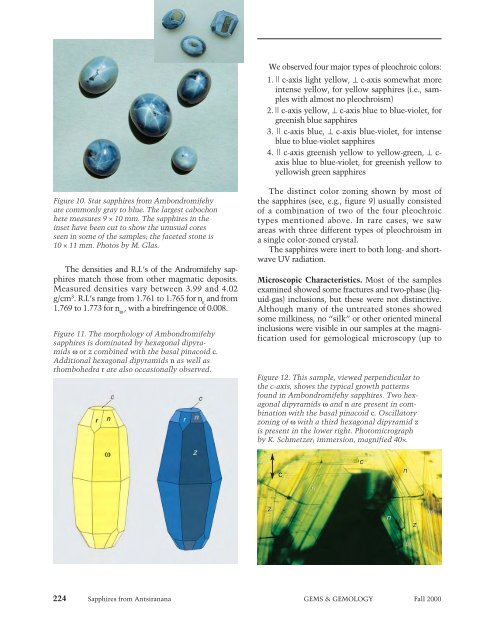Fall 2000 Gems & Gemology - Gemfrance
Fall 2000 Gems & Gemology - Gemfrance
Fall 2000 Gems & Gemology - Gemfrance
Create successful ePaper yourself
Turn your PDF publications into a flip-book with our unique Google optimized e-Paper software.
Figure 10. Star sapphires from Ambondromifehy<br />
are commonly gray to blue. The largest cabochon<br />
here measures 9 × 10 mm. The sapphires in the<br />
inset have been cut to show the unusual cores<br />
seen in some of the samples; the faceted stone is<br />
10 × 11 mm. Photos by M. Glas.<br />
The densities and R.I.’s of the Andromifehy sapphires<br />
match those from other magmatic deposits.<br />
Measured densities vary between 3.99 and 4.02<br />
g/cm 3 . R.I.’s range from 1.761 to 1.765 for n e and from<br />
1.769 to 1.773 for n w , with a birefringence of 0.008.<br />
Figure 11. The morphology of Ambondromifehy<br />
sapphires is dominated by hexagonal dipyramids<br />
w or z combined with the basal pinacoid c.<br />
Additional hexagonal dipyramids n as well as<br />
rhombohedra r are also occasionally observed.<br />
We observed four major types of pleochroic colors:<br />
1. || c-axis light yellow, ^ c-axis somewhat more<br />
intense yellow, for yellow sapphires (i.e., samples<br />
with almost no pleochroism)<br />
2. || c-axis yellow, ^ c-axis blue to blue-violet, for<br />
greenish blue sapphires<br />
3. || c-axis blue, ^ c-axis blue-violet, for intense<br />
blue to blue-violet sapphires<br />
4. || c-axis greenish yellow to yellow-green, ^ caxis<br />
blue to blue-violet, for greenish yellow to<br />
yellowish green sapphires<br />
The distinct color zoning shown by most of<br />
the sapphires (see, e.g., figure 9) usually consisted<br />
of a combination of two of the four pleochroic<br />
types mentioned above. In rare cases, we saw<br />
areas with three different types of pleochroism in<br />
a single color-zoned crystal.<br />
The sapphires were inert to both long- and shortwave<br />
UV radiation.<br />
Microscopic Characteristics. Most of the samples<br />
examined showed some fractures and two-phase (liquid-gas)<br />
inclusions, but these were not distinctive.<br />
Although many of the untreated stones showed<br />
some milkiness, no “silk” or other oriented mineral<br />
inclusions were visible in our samples at the magnification<br />
used for gemological microscopy (up to<br />
Figure 12. This sample, viewed perpendicular to<br />
the c-axis, shows the typical growth patterns<br />
found in Ambondromifehy sapphires. Two hexagonal<br />
dipyramids w and n are present in combination<br />
with the basal pinacoid c. Oscillatory<br />
zoning of w with a third hexagonal dipyramid z<br />
is present in the lower right. Photomicrograph<br />
by K. Schmetzer; immersion, magnified 40×.<br />
224 Sapphires from Antsiranana GEMS & GEMOLOGY <strong>Fall</strong> <strong>2000</strong><br />
z<br />
c<br />
n<br />
c<br />
n<br />
n<br />
w<br />
z<br />
w


